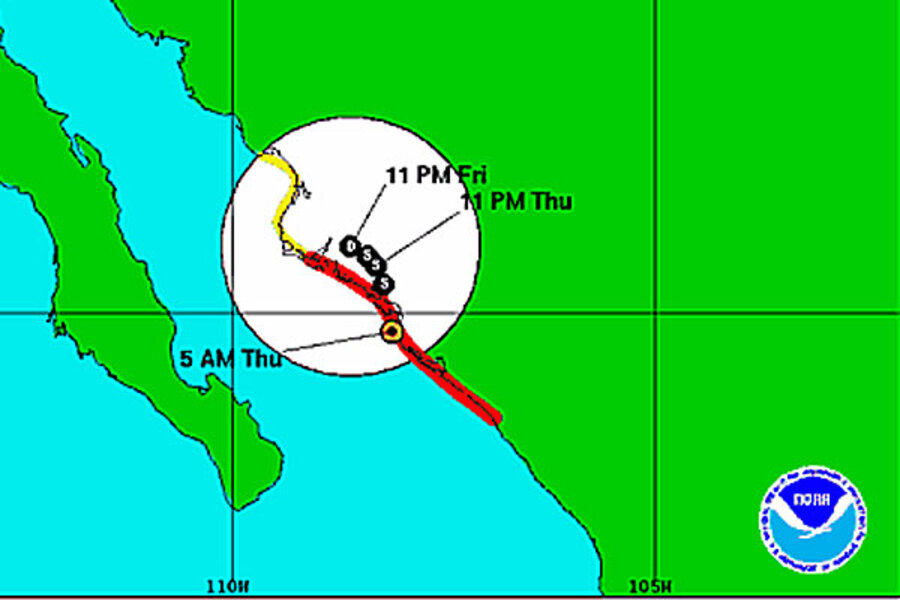Hurricane Manuel hammers Mexico
Loading...
| Acapulco, Mexico
Mexico's government said 58 people were missing after a massive landslide smashed through a tiny coffee-growing village deep in the country's southern mountains, where fresh waves of rain threatened to unleash more danger for rescue workers trying to evacuate the last residents from the isolated hamlet.
The storm that devastated Mexico's Pacific coast over the weekend regained strength Wednesday and became Hurricane Manuel, dumping rain on fishing villages on the coast of Sinaloa state. It is a third blow to a country still reeling from the one-two punch of Manuel's first landfall and Hurricane Ingrid on Mexico's eastern coast.
Federal officials raised the death toll from Manuel from 60 to 80 earlier Wednesday. They said they were not yet declaring the 58 dead in the village of La Pintada several hours north of Acapulco, but it appeared unlikely that they had survived.
"It's very likely that these 58 missing people lost their lives," Angel Aguirre, governor of storm-battered Guerrero state, told reporters.
The U.S. National Hurricane Center said Manuel was a Category 1 hurricane nearing Mexico's coast early Thursday and expected to produce 75 mph winds and between 8 and 12 inches of rain (and pockets of 20 inches in places) over the state of Sinaloa. The center of Manuel is expected to slowly move inland over western Mexico in the next 24 hours. The National Hurricane Center describes Manuel as a "small tropical cyclone" with hurricane force winds extending up to 15 miles from the center, and tropical storm winds (below 75 m.p.h.) extending outward up to 60 miles.
Sinaloa state civil protection authorities said some areas were already flooding and dozens were evacuated in an area of small fishing villages.
Heavy rains also began pelting the state of Guerrero again Wednesday night, increasing the risk for federal police trying to evacuate the last 45 residents of the village of La Pintada, where tons of dirt and rocks smashed through the center of town Monday night, burying a church and an untold number of two-story homes.
Federal authorities reached La Pintada by helicopter and evacuated 334 people, some of whom are hurt, one seriously, said Interior Minister Miguel Angel Osorio Chong.
Osorio Chong said there was a risk of more landslides for the federal police who stayed in the village overnight and hoped to leave with the last 45 residents on helicopters early Thursday morning.
He said the landslide went right through the middle of the village of some 600 people, accessible in normal conditions by winding mountain roads now broken multiple times by landslides and flooding.
In Acapulco, three days of Biblical rain and leaden skies evaporated into broiling late-summer sunshine that roasted thousands of furious tourists trying vainly to escape the city, and hundreds of thousands of residents returning to homes devastated by reeking tides of brown floodwater.
The depth of the destruction wreaked by Manuel, which first hit Mexico on Sunday as a tropical storm, was highlighted when the transportation secretary said it would be Friday at the earliest before authorities cleared and reconnected the parallel highways that connect this bayside resort to Mexico City and the rest of the world.
Hundreds of residents of Acapulco's poor outlying areas slogged through waist-high water to pound on the closed shutters of a looted Costco, desperate for food, drinking water and other basics.
Many paused and fished in the murky waters for anything of value piling waterlogged clothing and empty aluminum cans into plastic bags.
"If we can't work, we have to come and get something to eat," said 60-year-old fisherman Anastasio Barrera, as he stood with his wife outside the store.
With a tropical disturbance over the Yucatan Peninsula headed toward Mexico's Gulf coast, the country could face another double hit as it struggles to restore services and evacuate those stranded by flooding from Manuel and Ingrid, which hit the Gulf coast.
Mexico's federal Civil Protection coordinator, Luis Felipe Puente, said 35,000 homes were damaged or destroyed.
Elsewhere in the verdant coastal countryside of the southern state of Guerrero, residents turned motorboats into improvised ferries, shuttling passengers, boxes of fruit and jugs of water across rivers that surged and ripped bridges from their foundations over the weekend.
In Acapulco's upscale Diamond Zone, the military commandeered a commercial center for tourists trying to get onto one of the military or commercial flights that remained the only way out of the city. Thousands lined up outside the mall's locked gates, begging for a seat on a military seat or demanding that airline Aeromexico honor a previously purchased ticket.
"We don't even have money left to buy water," said Tayde Sanchez Morales, a retired electric company worker from the city of Puebla. "The hotel threw us out and we're going to stay here and sleep here until they throw us out of here."
Mexican officials said that at least 10,000 people had been flown out of the city on 88 flights by Wednesday evening, just part of the 40,000 to 60,000 tourists estimated to be stranded in the city.
A lucky few held up ransacked beach umbrellas against the sun. Temperatures were in the mid-80s but felt far hotter. Dozens of others collapsed in some of the few spots of shade.
"Forty-eight hours without electricity, no running water and now we can't get home," said Catalina Clave, 46, who works at the Mexico City stock exchange.
___
Associated Press writers Martin Duran in Culiacan, E. Eduardo Castillo, Mark Stevenson and Olga R. Rodriguez in Mexico City contributed to this report.
____
Michael Weissenstein on Twitter: https://twitter.com/mweissenstein
Copyright 2013 The Associated Press. All rights reserved. This material may not be published, broadcast, rewritten or redistributed.






